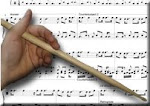 So, the next rather challenging measure in The Black Page is number twenty-six. Unlike measure fifteen, this one isn't particularly difficult to understand, it's just a little tricky to execute - particularly those two eleven note tuplets on beats three and four. That's a lot of notes crammed into a rather small space.
So, the next rather challenging measure in The Black Page is number twenty-six. Unlike measure fifteen, this one isn't particularly difficult to understand, it's just a little tricky to execute - particularly those two eleven note tuplets on beats three and four. That's a lot of notes crammed into a rather small space.(a minor digression)
So, what the heck do you call an eleven note tuplet, anyway? I did a bit of searching on line, but nothing seems to list anything beyond septuplet. In frustration, I searched for the names of polygons and found a math website that lists polygon names up to one hundred sides. An eleven sided polygon is referred to as a hendecagon. Okay, bringing it back to music, a ten sided polygon is called a decagon and a twelve sided polygon is called a dodecagon. I believe I have heard a ten note tuplet referred to as a decuplet and a twelve note tuplet as a dodecuplet. With that in mind, my first guess was that an eleven note tuplet would be called a hendecuplet. However, thanks to my good friend kevin Johnson, I can officially tell you that it is an undecuplet. Kevin directed me to http://www.dolmetsch.com/ an online music dictionary.
(back to the point)
As I said, that's a lot of notes crammed into a small space. There is, of course, one very logical way to approach a measure like this: go really slow and use a metronome. By the way, the undecuplet figures are used again in measure twenty-eight which contains the nested polyrhythm from measure five (slightly reconfigured) and two undecuplets on the back end of the measure. I will post more about that one when I get to it.


No comments:
Post a Comment